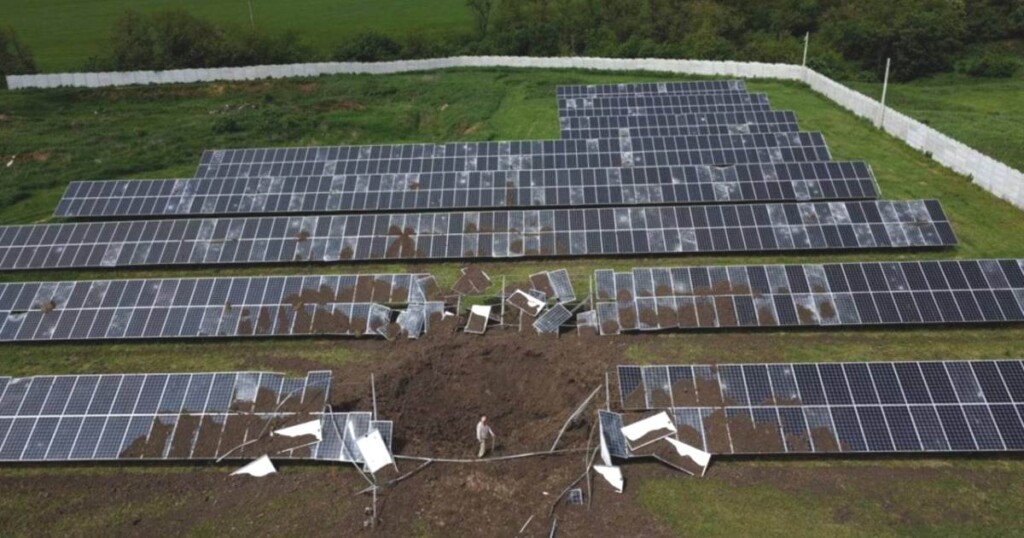Renewable Energy market of Ukraine before and after the war.


Ukraine’s green path to energy independence and investment opportunities for foreign partners.
Renewable energy began being actively developed in Ukraine after 2014 – at the end of the year’s first half, the total capacity of RES facilities operating under the “green tariff” amounted to 1,419 MW. By the end of 2019, these facilities had a total installed capacity of 4,658 MW. Moreover, in the pre-war year of 2021, the green tariff brought another 731 MW of industrial renewable energy capacities online. As a result, as of the year’s end, these facilities’ total capacity reached 9,656 MW (including domestic SPPs, or 8,450.8 MW without them).
For 2022, the state also had ambitious plans for reforming and developing green energy. Then, however, the war changed everything. It is true that happiness and unhappiness ride on the same sled. According to an energy market study conducted by the Pershe Agency, we can safely conclude that renewable energy should now become one of the foundations for Ukraine’s post-war reconstruction and the further increase of the country’s energy independence. During the war, Ukraine maintained its green transition plans and remained an attractive haven for foreign investments.
According to the Ministry of Energy of Ukraine, the state will continue to develop nuclear and green energy in the coming decades, while coal will lose demand completely by 2040. The share of renewable energy sources in the energy balance is expected to reach 25% in 2032 and double by 2050. By 2032, Ukraine plans to build two new nuclear units and launch small modular reactor pilot projects.
Energy industry before the war.
In 2019, Ukraine entered the top ten countries in the world in terms of the rate of renewable energy development, and in 2020 will enter the top five European countries in terms of the rate of solar energy growth. In the 2019 Climatescope rating by Bloomberg, NEF Ukraine was ranked eighth (up from 63rd) among 104 countries in terms of the country’s investment attractiveness, precisely in the context of the development of low-carbon energy sources and the construction of a green economy. In 2021, Ukraine was in 48th place among 136 countries in this rating.


Since 2019 investment in new renewable energy projects in Ukraine has been consistently higher than fossil fuel projects. Over the past ten years, leading international and Ukrainian RES investors have attracted more than $12B of foreign direct investment into the economy. As a result, the share of foreign investors in the installed RES capacity by the end of 2021 had reached more than 35%. This means that the Ukrainian RES sector is quite competitive and accessible.
The list of the sector’s largest international creditors and investors include: the EBRD, Black Sea Trade and Development Bank, American International Development Finance Corporation (DFC), Federal Land Bank Bavaria BayernLB, Investment Fund for Developing Countries (IFU), Nordic Environmental Finance Corporation ( NEFCO) and many others. And these investors are representatives from such countries as China, the USA, Great Britain, Germany, the Netherlands, Sweden, Denmark, Norway, France, Luxembourg, Belgium, Spain, Canada, and Turkey.
RES and the War.
As of August 2022 in Ukraine, according to experts’ estimates, 30–40% of green power plants, approximately 1,120 to 1,500 MW in the southern and southeastern regions, where most RES capacities are concentrated and active hostilities are present, have been affected by the war. During the half year of the war, wind and solar energy generation decreased by more than 50% compared to the pre-war level. This happened both as a result of the destruction of energy facilities and energy stations shot-downs to prevent damage to electrical equipment. In addition, problems related to the destruction of demand and high-generation inflexibility have intensified. And this means that Ukraine needs to restore destroyed RES stations, improve its system, and increase capacity. And for this, the country will require significant investment.


It is also worth noting that in March 2022, the power systems of Ukraine and Moldova were fully synchronized with continental Europe’s ENTSO-E power grid. And this opens a new window of opportunity for green power generation. Ukrainian electricity, primarily generated from RES, has become very attractive for European consumers. After all, its cheap import makes it possible to reduce their electrical bills. As a result, Ukrainian companies can earn up to €9.5B in profit per year if the connection capacity with neighboring Hungary, Poland, Romania, and Slovakia is increased to 2.5 GW.
Another positive wartime decision is a law on the development of energy storage systems, which provides for the launch of large-scale construction of energy storage systems in Ukraine, which are extremely important for an inflexible energy system such as Ukraine’s. And here, we also see a window for investment.
Green relations with international partners.
At the global level, in order to spread green energy, Ukraine must constantly try to attract investment from European countries and participate in joint projects with Great Britain, Spain, Germany, and other countries.
Ukraine has especially active cooperation with Germany. Recently, the Minister of Energy of Ukraine, Herman Galushchenko, and his German colleague Robert Habek signed a joint Statement of Intent in Kyiv, which expands the directions of the German-Ukrainian energy partnership, emphasizing the green recovery and reconstruction of Ukraine’s energy industry. Habek also promised that his country would allocate €1M for Ukraine’s green restoration projects.
Finland is also interested in the Ukrainian green energy sector. At the end of last year, a meeting was held at the Ministry of Energy of Ukraine with representatives of the Finnish energy company ENERSENSE, which specializes in energy services with zero emissions and supports the transition to renewable energy sources. The parties discussed the attraction of investment for restoring and modernizing the Ukrainian energy system, including RES. “Ukraine has a significant potential for developing renewable energy – solar, wind, and small hydro generation. The realization of this potential will stimulate the need to construct energy storage facilities for balancing peak loads, which will also become an attractive investment direction for the business. In addition, the construction of new generation will require developing and modernizing power grids,” noted Deputy Minister of Digital Transformation Farid Safarov. ENERSENSE representatives have confirmed their interest in cooperation.
Close, further cooperation with Ukraine in the energy sector, including RES, was announced last summer at the American Chamber of Commerce.
In retrospect, from 2015 to 2020, at least 8 of Ukraine’s 11 largest solar stations were created with Chinese investment. As well, investment has come from the Spanish company Acciona Energia (€53.7M for the construction of a power plant near Kyiv), the Norwegian Scatec Solar (€24.5M for the construction of a power plant near Cherkasy), the French-Ukrainian Main Group Ukraine (€90M for the construction of power plants in Dnipro) and others.
At the beginning of 2019, the French company Total-Eren announced its entry into the Ukrainian wind power market. The company constructed the Syvash wind power station with the Norwegian company NBT. The project’s total budget is more than €350M, of which €150M was provided by the EBRD.
There were also foreign investments in bio and hydropower in the period after 2014 and before the war. In 2020, €1.24 billion was invested in green energy, including €46 million in energy efficiency projects through the “warm credit” program and the energy service. Another €1.2 billion has been invested in 1.6 GW of new capacity for generating electricity from renewable sources.
The set of projects mentioned above demonstrates the scale and number of foreign players in the Ukrainian green energy market. Notably, Ukraine has a resource that accumulates information about renewable energy and energy efficiency projects — UAmap. This tool enables interested parties to become acquainted with each of them in detail.
A kaleidoscope of possibilities.
Ukraine’s Recovery and Development Plan covering 2022 to 2032 was presented in July 2022 at the international donor conference in Lugano and includes the construction of five to seven GW of new solar and wind power plants to expand Ukraine’s export capacity, 30+ GW of RES facilities for the production of renewable hydrogen and 3.5 GW of hydroelectric and pumped hydroelectric plants. Additionally, over the next 10 years, the Plan provides for commissioning 1.5-2 GW of peak power, 0.7-1 GW of batteries, and 15 GW of electrolysis capacity.


The volume of future investments in the national Energy Independence and Green Course program is estimated at $130B.
At the same time, the wind energy sector, for example, has even greater potential. A professional association claims it can add at least seven GW of new wind turbines to the existing installed capacity by 2030. This is explained by the fact that before the war, four GW of new wind energy projects had already received construction permits, and most were planned to be put into operation by 2024-2026. In addition, the average wind turbine unit power proposed for operation at new wind farms starting in 2021 is six MW and above. The bioenergy sector and replacing natural gas with biomass and solid biofuel also have extensive potential. As for solar generation, it is assumed that the sector of small solar generation – home SPPs – will first be actively developed. The recovery plan until 2032 also includes the development of the renewable hydrogen market. It is synchronized with the previously established goals in the hydrogen strategy. By 2030, Ukraine should have installed 10 GW of capacity for producing renewable hydrogen, 75% of which can be exported to interested European countries, primarily Germany.


Energy Independence of Ukraine and Europe.
The war shifted the value of renewable energy sources from more climatic to security and economic. After all, alternative energy will allow Ukraine to gain independence from external conditions and circumstances, sell electricity to Europe, and have an additional source of revenue for the state budget and the country’s GDP, primarily because the EU’s electricity cost is much higher than in Ukraine. In addition, it is an ideal sector for attracting foreign investment, especially from Europe, which seeks to eliminate dependence on fossil fuels mainly from unfriendly Russia.







